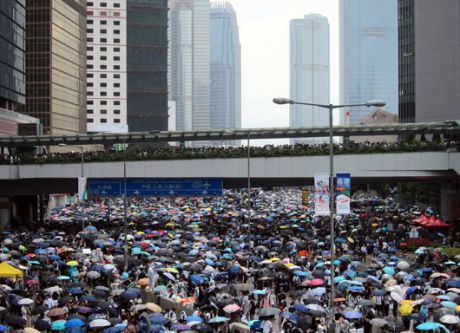News
You are here
World Revolt: Uprisings are driven by common trends

November 24, 2019
The protests around the globe may not be a coordinated wave, but they share long-term roots, writes Joseph Choonara.
Chile: millions on the streets, protests and strikes amid images of burning buildings. Ecuador: the government flees the capital in the face of demonstrations. Hong Kong: five months of pitched battles between police and protesters. Catalonia: a general strike in response to the jailing of pro-independence politicians.
Lebanon: barricades erected as a mass movement ousts the prime minister. Haiti: after waves of anti-government protests, police take to the street over unpaid wages. Iraq: protesters demand that all government officials are tried for corruption. Guinea: hundreds of thousands mobilise to block constitutional changes allowing the president to seek a third term.
Add to this the rebirth of protest in Egypt, July’s ousting of the Puerto Rican governor, earlier Algerian and Sudanese uprisings, and it becomes clear we are seeing a new global cycle of struggle.
This is not a coordinated movement, but looking below the surface it is possible to identify common long-term trends driving the resistance.
The first is the sheer scale and power of the global working class. For the first time in human history, most people live in urban settings and most rely, at least in part, on wage labour. Many recent struggles have given an important role to strikes — the most obvious expression of workers’ collective power.
A fascinating recent study by academics in Oslo looked at struggles for democracy over the past century, concluding that “industrial workers are key agents of democratisation”, providing movements with power and cohesion. They argue that this connection has deepened in recent decades and is most pronounced as societies urbanise.
The growth of the working class comes alongside another trend — the declining capacity of capitalism to address the aspirations of those living under it. The period since the late 1970s saw relatively weak growth across much of the capitalist system, in spite of localised booms in countries such as China.
The crisis of 2008-9 has mutated into a “new normal” of even weaker and more unstable growth almost everywhere. One consequence has been a sharpening of tensions between those at the top of society and those at the bottom.
Recent struggles almost universally express rage over inequality. Sometimes they are rallying against “corruption” — typically meaning that a tiny, self-serving elite enjoys life in a manner utterly detached from the conditions of those they exploit.
Moreover, economic weakness imposes a pressure on governments to drive through new attacks. Ecuador’s uprising was triggered by an IMF-backed austerity programme. The spark in Lebanon was tax rises, including the introduction of a tax of WhatsApp calls, in Chile, increases to public transport fares.
Even when attacks are withdrawn, protests tend to continue. They are politicised by state repression and sustained by the broader backdrop of bitterness and indignation.
This brings us to another long-term trend — disengagement between populations and mainstream politics. The roots of this lie in the convergence of politicians on neoliberal policies from the 1980s, but this trend too has accelerated since 2008-9.
This can create an opening for right wing politicians — with figures such as Jair Bolsonaro in Brazil or Narendra Modi in India the beneficiaries. But the current struggles show that it can also generate mass protest movements, creating openings to the left.
Forces available
This poses the question of the socialist forces available. A recent Guardian article explored the struggles taking place in Latin America. One of the experts interviewed commented: “People have been talking about whether this is the Latin American spring. And I really don’t think it is because…there is absolutely no one waiting in the wings. So I think it is bound to mostly end in tears.”
The implied contrast with the Arab Spring is an odd one. In those struggles, too, the limited size and implantation of the radical left allowed the initiative to pass to the capitalist state. This is particularly evident in Egypt, where former general Sisi was able to take power, crushing dissent.
But it is also necessary to ask what kind of politics can offer a way forward. An earlier wave of struggles in Latin America, from the late 1990s to the mid-2000s, was contained precisely because — waiting in the wings — were a series of left-nationalist figures. Evo Morales in Bolivia or Rafael Correa in Ecuador, and less radical counterparts such as Lula in Brazil, reflected the radicalism of the struggles but sought to integrate it into the existing state.
They were able to stabilise their rule with revenue from the global commodities boom, offering social programmes for the poor without seriously encroaching on capitalist interests. Today the commodities boom is over. The rebellion in Ecuador is against Correa’s chosen successor, and Morales is also facing protests.
A key question for the current struggles is whether a new socialist politics can be forged within them, going beyond attempts to incorporate demands from below while simply seeking to manage capitalism more effectively. This is an era in which revolutionary politics is desperately needed.
This article was originally posted by Socialist Review at: http://socialistreview.org.uk
Section:










